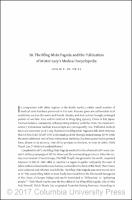Chapter 58 The Đồng Nhân Pagoda and the Publication of Mister Lazy’s Medical Encyclopedia
| dc.contributor.author | De Vries, Leslie E. | |
| dc.date.accessioned | 2021-06-01T08:18:04Z | |
| dc.date.available | 2021-06-01T08:18:04Z | |
| dc.date.issued | 2017 | |
| dc.identifier.uri | https://library.oapen.org/handle/20.500.12657/48878 | |
| dc.description.abstract | In comparison with other regions in the Sinitic world, a rather small number of medical texts has been preserved in Vietnam. Reasons given are unfavorable local conditions, such as the warm and humid climate, and destruction through prolonged periods of warfare. Also, and in contrast to Ming-Qing dynasty China or Edo Japan, Vietnam lacked a commercial, urban printing industry until the 1920s. Pre–twentieth-century Vietnamese medical manuscripts are consequently rare. Published medical texts are even more so. It’s only thanks to the Đồng Nhân Pagoda in Bắc Ninh Province that Lê Hữu Trác’s (1720?–1791) Understandings of Hải Thượng’s Medical Lineage (1770–1786), the most celebrated text of Sino-Vietnamese medicine, has been preserved in printed form, almost in its entirety.1 One of the prefaces to this text, written by abbot Thích Thanh Cao (?–1896), is translated below | en_US |
| dc.language | English | en_US |
| dc.subject.classification | bic Book Industry Communication::M Medicine | en_US |
| dc.subject.classification | thema EDItEUR::M Medicine and Nursing | en_US |
| dc.subject.other | medicine; medical encyclopedia | en_US |
| dc.title | Chapter 58 The Đồng Nhân Pagoda and the Publication of Mister Lazy’s Medical Encyclopedia | en_US |
| dc.type | chapter | |
| oapen.relation.isPublishedBy | 74662b9b-7bc3-4816-b051-203e0eaf16db | en_US |
| oapen.relation.isPartOfBook | 1fc8e806-33ba-49c5-b6dd-db21f64f3176 | en_US |
| oapen.relation.isFundedBy | d859fbd3-d884-4090-a0ec-baf821c9abfd | en_US |
| oapen.collection | Wellcome | en_US |
| oapen.pages | 6 | en_US |
| oapen.place.publication | New York | en_US |

